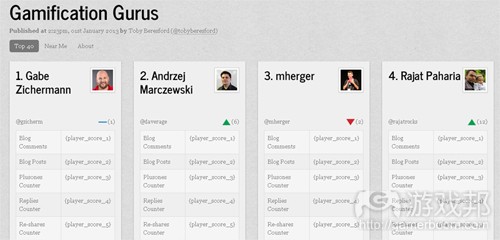阐述玩家排行榜的作用及设计窍门
作者:Andrzej Marczewski
为了快速反映玩家在游戏化系统中的当前地位,使用排行榜是一种高效的方法。如Leaderboarded公司的Gamification Gurus排行榜就是一个有趣的例子。
每个月,他们会公布一次更新,显示那个月在游戏化世界中表现活跃的玩家。这是一个独立使用排行榜的好例子——通常与游戏相关的积分和徽章无关。
现在有许多博客和网站都利用评论系统Disqus来管理评论。如果你打算使用它管理网站上的评论,你只需要若干个容易添加的插件。一个是Top Commenter,它显示的是在你的页面上发表评论最多的人。
从用户的角度看,它把用户的活跃度置于网站的前沿和中心,可以鼓励他们(在小小的同伴竞争的压力下)多多发表评论,以便在排行榜上靠前。它还显示了他们在其他Disqus论坛的活动情况,这是用户在你的网站上留下评论的另一个原因。看到他们在其他网站上做的评论的人越多,用户就越有机会散播个人影响力。
绝对排行榜和相对排行榜
排行榜有多种执行办法,但我只介绍其中两种——即我所谓的绝对排行榜和相对排行榜。
绝对排行榜只展示排名前X位的人。这么做有优点也有缺点。对于出现在排行榜上的人来说,这让他们产生成就感和满足感,是件好事。有些人可能希望找出在某活动中表现最好的人,这种排行榜对这类人来说也是实用的。可以说,如果某人名列排行榜前茅,那么至少值得考虑这个人!然而,对于那些名列排行榜末端或甚至没进排行榜的人来说,这种排行榜的作用就比较消极了。如果你名列第100名,那么第1名简直就是遥不可及的目标!对于一些人而言,这可能是一个很棒的挑战,但另一些人会直接放弃。
为了避免绝对排行榜的弊端,相对排行榜采用另一种做法:显示用户与其他等级接近的用户的相对排名。所以,假设你是1000人中的第900名,你在排行榜上只会看到在你前面和后面的10个人。这样,你就不会觉得争取第1名是不可能的事了——因为你感觉不到这个目标离你有多远!但是,相对排行榜还是有缺点。第一个其实是技术性问题。为了显示用户的相对名次,你得知道他们是谁——所以他们必须在系统中登录(这样系统才能识别你是谁)。另一个问题是,知道谁与你的表现差不多似乎没什么意义。正如我所说的,有些人喜欢迎接挑战。
当然,解决方案可能是能同时看到绝对和相对排名!
除了显示排名,排行榜还有其他作用。如果排行榜显示的是你和你的同事朋友们的排名,你可能会感到社交同伴带来的压力。有许多人想在同伴中争得这种简单的排行榜上的头名,真是令人惊讶的现象。排行榜还能快速反馈用户的表现。当你完成某事时,在排行榜上的名次上升充分显示了你做对了某事。另外,它可以成为一种强大的社交联系工具。正如我所说的,如果某人的排名靠前,他也非常可能是值得交谈的人!
顺便一提,如果你用排行榜来显示在某领域(游戏邦注:比如在社交媒体上表现活跃)达到某成就的人,但只使用标签云图,而不是直接给出名次,那么这就变成一种反映谁的活跃度高的方法,而不至于导致激烈的竞争。
虽然这只是处于游戏化世界的我们能使用到的许多工具中一个小附件,但却开了一个好开头。甚至还有一些预制的奖励系统,如Punchtab,可以添加到网站和博客上。(本文为游戏邦/gamerboom.com编译,拒绝任何不保留版权的转载,如需转载请联系:游戏邦)
a little bit on Leaderboards
by Andrzej Marczewski
Leaderboards are an effective way to show a user quickly where they currently stand within a gamified system. A fun example is the Gamification Gurus leaderboard from the company Leaderboarded.
Each month they release an update that shows who has been active in the gamification world that month. It is a great example of a leaderboard being used in isolation – without all of the points and badges that are often associated with simple gamification.
Gamification a Little on Leaderboards gamification
Many blogs and websites these days make use of a comment system called Disqus to manage their comments. It had a few plug-ins that you can easily add to your site if you are using it for comments. One is a Top Commenter’s box. It shows people, at a glance, who is posting the most comments on your pages.
From a user standpoint, it puts their activity front and centre on the site, which will hopefully motivate them (with a little bit of peer pressure) to comment more to move up the leaderboard. It also shows you their activity on other Disqus forums, which is another reason for them to leave comments with you. The more people who see the comments they are making on other sites, the more chance there is they can spread their own influence.
Absolute and Relative Leaderboards
There are several ways to implement leaderboards, but I want to concentrate on just two that I will refer to as absolute and relative leaderboards.
An absolute leaderboard will display the top X number of people on the leaderboard. This has pros and cons. It is great for the people who are visible on the Leaderboard, it can give them a feeling of achievement and status. It is also useful for others who may want to see who is best at a certain activity. It is a safe bet that if they are at the top of the leaderboard, they are at least worth considering! However, it can be very de-motivational for those at the bottom or even not on the leaderboard at all. If you are in 100th place, the top spot can look like a totally unachievable goal! For some, this may be a great challenge, but others will disengage almost totally.
Relative leaderboards try to solve this issue by showing a users position relative to others of a similar rank. So, whilst you may be 900th out of 1000, you only see the 10 people above and below you on the leaderboard. This means that you don’t get the issue of feeling inadequate or that there is no hope of ever reaching the top – you are less aware of how far down the list you are! Again, there are downsides to this. One is actually technical. To show a users relative position, you have to know who they are – so they have to be logged in to a system (so that it knows who you are). The other issue is that it could be seen as meaningless just knowing who is doing the same as you. As I said, some people like to see the challenge ahead of them.
Of course the solution may be (as with Leaderboarded) to have the option to see either view!
As well as displaying status, leaderboards can serve other purposes. If the leaderboard is set up to show you in relation to colleagues of friends, you may find that social peer pressure comes in – one-up-manship. It is amazing how many people in a peer group will want to hit the top spot of a simple leaderboard. They can be great forms of rapid feedback for users. Rising up the leaderboard as you succeed at tasks is a very visible sign that you are doing something right. Also, it can be a great social connection tool. As I said, if people are near the top of a leaderboard it is a safe bet they are worth talking too!
As an aside, if you are using a leaderboard as a way to surface people who are achieving things in a particular area (say very active on social media), rather than giving them positions, just show them in somthing like a tag cloud. This then becomes a way of showing who is active, but not making it into a competition.
Whilst this is only a small subset of the tools available to us in gamification, it is a good place to start and there are even some premade reward systems, such as Punchtab, which you can apply to sites and blogs.(source:gamasutra)
上一篇:解析玩家进程与游戏进程的不同设计
下一篇:阐述游戏设计基本原则之测试阶段









































